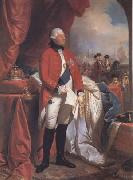Wholesale Oil Painting No Minimum |
|||||||||||
|
|
|||||||||||

|
|||||||||||
|
|
|
||||||||
Benjamin West1738-1820 Benjamin West Locations Benjamin West RA (October 10, 1738 ?C March 11, 1820) was an Anglo-American painter of historical scenes around and after the time of the American War of Independence. He was the second president of the Royal Academy serving from 1792 to 1805 and 1806 to 1820. In 1760, sponsored by Smith and William Allen, reputed to be the wealthiest man in Philadelphia, West traveled to Italy where he expanded his repertoire by copying the works of Italian painters such as Titian and Raphael. As painted by Gilbert Stuart, 1783-84West was a close friend of Benjamin Franklin, whose portrait he painted. Franklin was also the godfather of West's second son, Benjamin. In 1763, West moved to England, where he was commissioned by King George III to create portraits of members of the royal family. The king himself was twice painted by him. He painted his most famous, and possibly most influential painting, The Death of General Wolfe, in 1770, exhibited at the Royal Academy in 1771. Although originally snubbed by Sir Joshua Reynolds, the famous portrait painter and President of the Royal Academy, and others as over ambitious, the painting became one of the most frequently reproduced images of the period. In 1772, King George appointed him historical painter to the court at an annual fee of £1,000. With Reynolds, West founded the Royal Academy of Arts in 1768. He was the second president of the Royal Academy from 1792 to 1805. He was re-elected in 1806 and was president until his death in 1820. He was Surveyor of the King's Pictures from 1791 until his death. Many American artists studied under him in London, including Charles Willson Peale, Rembrandt Peale, Gilbert Stuart, John Trumbull, and Thomas Sully. [3] West is known for his large scale history paintings, which use expressive figures, colours and compositional schemes to help the spectator to identify with the scene represented. West called this "epic representation". He died in London. |
||||||||
|
|
||||||||
George III (mk25)
George III (mk25) Painting ID:: 24234 |
1779 1779 |
|||||||
|
|
||||||||
|
Allan Ramsay 1713-1784 British Allan Ramsay Galleries Allan Ramsay was born in Edinburgh, Scotland, the eldest son of Allan Ramsay, poet and author of The Gentle Shepherd. Ramsay's first wife, Anne Bayne, by Ramsay Ramsay's second wife Margaret Lindsay, by RamsayFrom the age of twenty he studied in London under the Swedish painter Hans Huyssing, and at the St. Martin's Lane Academy; leaving in 1736 for Rome and Naples, where he worked for three years under Francesco Solimena and Imperiali (Francesco Fernandi). On his return in 1738 he first settled in Edinburgh, attracting attention by his head of Duncan Forbes of Culloden and his full-length portrait of the Duke of Argyll, later used on Royal Bank of Scotland banknotes. He later moved to London, where he was employed by the Duke of Bridgewater. His pleasant manners and varied culture, not less than his artistic skill, contributed to render him popular. His only serious competitor was Thomas Hudson, with whom he shared a drapery painter, Joseph van Aken. In 1739 he married his first wife, Anne Bayne, the daughter of a professor of Scots law at Edinburgh, Alexander Bayne of Rires (c.1684?C1737), and Mary Carstairs (1695??C1759). None of their 3 children survived childhood, and she died on 4 February 1743 giving birth to the third of them. One of his drawing pupils was Margaret Lindsay, eldest daughter of Sir Alexander Lindsay of Evelick and Amelia Murray (granddaughter to David Murray, 5th Viscount of Stormont and sister to the naval officer John Lindsay). He later eloped with her and on 1 March 1752 they married in the Canongate Kirk, Edinburgh, though her father never forgave her for marrying an artist. Ramsay already had to maintain a daughter from his previous marriage as well as his two surviving sisters, but told Sir Alexander that he could provide Margaret with an annual income of £100 which would increase ??as my affairs increase, and I thank God, they are in a way of increasing?? and that his only motive for the marriage was ??my love for your Daughter, who, I am sensible, is entitled to much more than ever I shall have to bestow upon her??. There were three surviving children from their long and happy marriage, Amelia (1755?C1813), Charlotte (1758?C1818?), and John (1768?C1845). Ramsay and his new wife spent 1754?C1757 together in Italy, going to Rome, Florence, Naples and Tivoli, researching, painting and drawing old masters, antiquities and archaeological sites, and (to earn an income) painting Grand Tourists' portraits. This and other trips to Italy involved more literary and antiquarian research than art. After their return, he was in 1761 appointed to succeed John Shackelton as Principle Painter in Ordinary to George III, beating Hudson to the post; and so fully employed was he on the royal portraits which the king was in the habit of presenting to ambassadors and colonial governors, that he was forced to take advantage of the services of a host of assistants--of whom David Martin and Philip Reinagle are the best known. He gave up painting in about 1770 to concentrate on literary pursuits, his health shattered by an accidental dislocation of the right arm and his second wife's death in 1782. With unflinching pertinacity, he struggled until he had completed a likeness of the king upon which he was engaged at the time, and then started for his beloved Italy, leaving behind him a series of fifty royal portraits to be completed by his assistant Reinagle. For several years he lingered in the south, his constitution finally broken. He died at Dover on 10 August 1784. George III (mk25) 1760-61 |
||||||||
|
|
||||||||
|
Prev Next
|
||||||||
|
|
||||||||
|
Related Paintings to Allan Ramsay :. |
||||||||
|
|
||||||||
|
CONTACT US |

